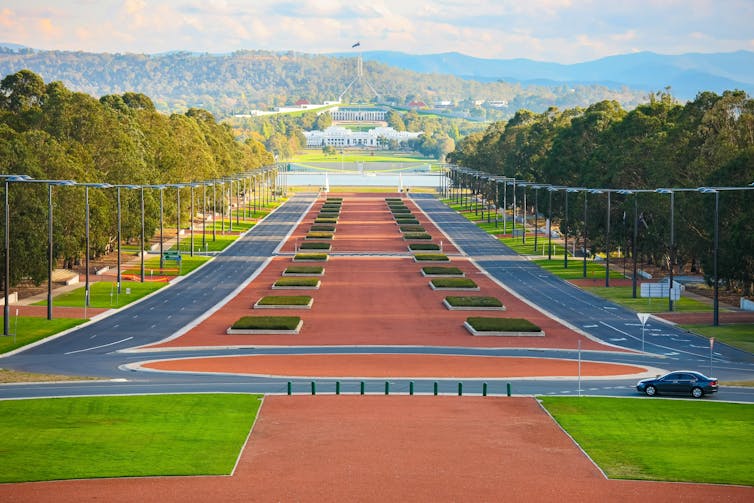The Coalition’s costings show some savings, but a larger deficit than Labor in the first two years
- Written by Stephen Bartos, Professor of Economics, University of Canberra

The Coalition’s policy costings[1] have been released, just two days ahead of the federal election.
The costings show the Coalition would run up a larger budget deficit than Labor in the first two years of government, but make a greater contribution to budget repair in years three and four.
This arises because two big-spending Coalition policies – the fuel excise reduction and cost of living tax offset – are short term. Their impact on the deficit disappears after year two.
Shadow Treasurer Angus Taylor said the deficit would narrow by A$14 billion by the end of the fourth year.
There are other spending initiatives – notably a significant increase in defence rising to $5.7 billion by the last year of the estimates, 2028-29. This will bring defence spending to 2.5% of gross domestic product (GDP).
The vexed question of nuclear costings
On the vexed question of nuclear power, the statement promises to fund the program primarily through equity investments[2] in exchange for an ownership stake.
These do not appear in the budget, on the premise that they fund commercial activities. This funding is estimated to total $118.2 billion by 2050 – well short of the $600 billion Labor has estimated[3] the proposal will cost. There is no independent Parliamentary Budget Office costing of the number – it is based on Coalition modelling.
Smaller sums are proposed for “community engagement” on nuclear technology ($87 million over four years) and a nuclear coordinating authority and training facility ($65 million). Both look to be in the right ballpark; they are however tiny compared with the costs of building nuclear reactors.
Items to reduce the budget deficit include income tax increases by abolishing Labor’s top-up tax cut[4] and public service reductions. In 2028-29 the tax increase raises $7.4 billion and public service cuts save $6.7 billion.
A range of savings measures
There are numerous other savings, including:
- taxation of vaping products
- reduction in a variety of environmental programs
- reversing tax incentives for electric vehicles
- cuts to the Housing Australia Future Fund
- reduced spending on overseas aid
- restoring the activity test for childcare
- changing eligibility for several government welfare payment programs.
It is a long and detailed list.
Most of the savings appear achievable, with the notable exception of cuts to the public service. It will be close to impossible to achieve a saving of 41,000 public servants in Canberra alone without forced redundancies.
The total Canberra public service workforce according to the Australian Public Service Commission[5] is only around 68,000.
At the press conference announcing the costings, Opposition spokesperson Jane Hume said however the figure was 110,000.
It is not clear where that number comes from. If the Coalition is using a different set of public service numbers to those published by the Australian Public Service Commission, it should identify where the extra come from. Off a larger base the savings would be difficult, but not completely infeasible.
As with the Labor proposal[7] to cut consultants, it still leaves the question of what will happen to the work those public servants were doing. Without changes to programs or activities, the Coalition will need to spend budget funds to get the work done.
Too late for the early voters
The costing release comes after more than 4.8 million Australians have already cast their vote[8]. This is less than ideal[9] for helping inform voters’ choices.
There is precedent for releasing costings late. The Albanese opposition similarly released costings on the Thursday[10] before polling day in 2022.
This week, the Labor government released its costings on Monday[11].
It is not clear what drives the practice of late release. One possibility is small target strategy: the less detail there is to criticise the more comfortable an opposition feels.
There is so much detail in this Coalition announcement, and so many interest groups potentially offended, that the caution about its release may be justified.
Savings previously announced[12] by the Coalition include scrapping production tax credits for critical minerals and hydrogen and removing fringe benefit tax breaks for electric vehicles.
The Coalition also plans to scrap some of the government’s off-budget funds and measures, including the Rewiring the Nation fund for electricity transmission and the Housing Australia Future Fund.
References
- ^ policy costings (www.liberal.org.au)
- ^ equity investments (www.pbo.gov.au)
- ^ Labor has estimated (www.afr.com)
- ^ top-up tax cut (budget.gov.au)
- ^ Australian Public Service Commission (www.apsc.gov.au)
- ^ Phillip Kraskoff/Shutterstock (www.shutterstock.com)
- ^ Labor proposal (theconversation.com)
- ^ already cast their vote (www.theguardian.com)
- ^ less than ideal (theconversation.com)
- ^ Thursday (thewest.com.au)
- ^ on Monday (theconversation.com)
- ^ Savings previously announced (www.smh.com.au)
Authors: Stephen Bartos, Professor of Economics, University of Canberra







